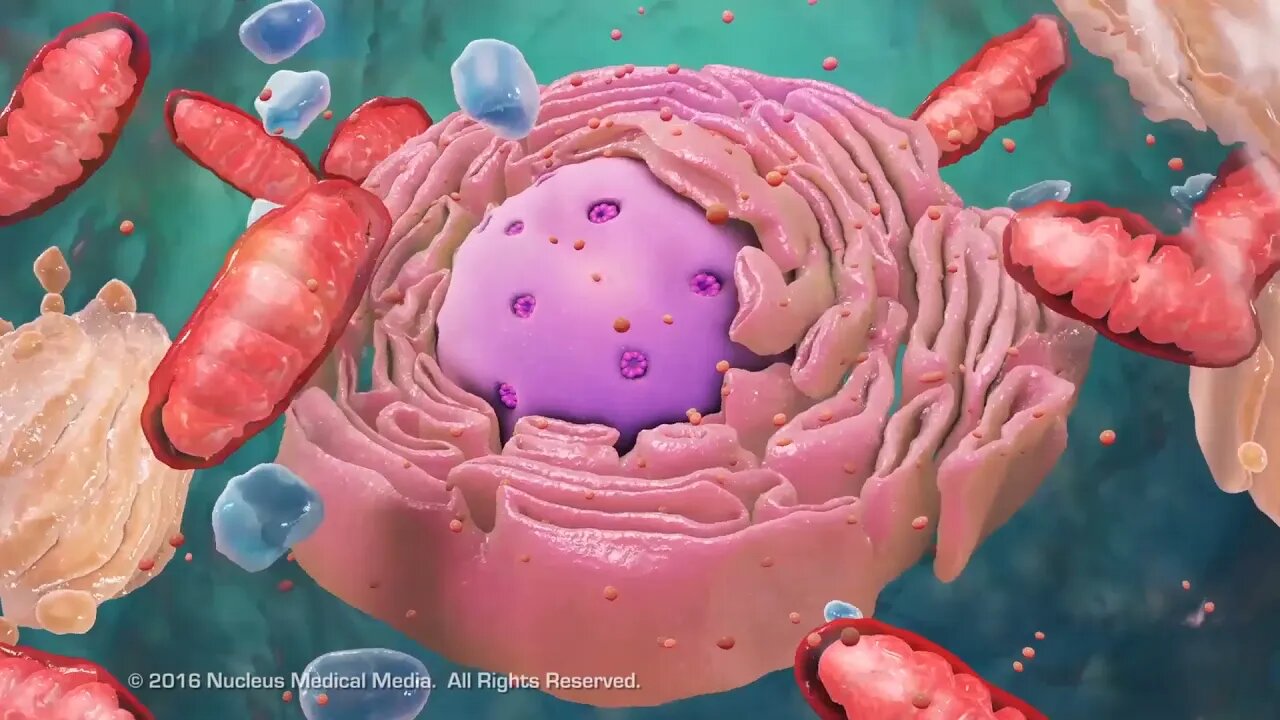Premium Only Content

Overview of Cell Structure
For Employees of hospitals, schools, universities and libraries: download up to 8 FREE medical animations from Nucleus by signing up for a free trial at: http://nmal.nucleusmedicalmedia.com/biology_youtube
SCIENCE ANIMATION TRANSCRIPT: [music] Cells are the smallest living units of an organism. All cells have three things in common, no matter what type of cell they are. All cells have a cell membrane which separates the inside of the cell from its environment. Cytoplasm, which is a jelly-like fluid, and DNA, which is the cell's genetic material. There are two broad categories of cells. The first category is eukaryotic cells. They have organelles which include the nucleus and other special parts. Eukaryotic cells are more advanced complex cells such as those found in plants and animals. The second category is prokaryotic cells. They don't have a nucleus or membrane-enclosed organelles. They do have genetic material, but it's not contained within a nucleus. Prokaryotic cells are always one-celled or unicellular organisms, such as bacteria. [music] So, what are organelles? Organelle means little organ. Organelles are the specialized parts of a cell that have unique jobs to perform. Let's start with the nucleus, the control center of the cell. The nucleus contains DNA, or genetic material. DNA dictates what the cell is going to do and how it's going to do it. Chromatin is the tangled spread out form of DNA found inside the nuclear membrane. When a cell is ready to divide, DNA condenses into structures known as chromosomes. [music] The nucleus also contains a nucleolus, which is a structure where ribosomes are made. After ribosomes leave the nucleus, they will have the important job of synthesizing, or making, proteins. [music] Outside the nucleus, the ribosomes and the rest of the organelles float around in cytoplasm, which is the jelly-like substance. Ribosomes may wander freely within the cytoplasm or attach to the endoplasmic reticulum, sometimes abbreviated as ER. There are two types of ER. Rough ER has ribosomes attached to it. And smooth ER doesn't have ribosomes attached to it. The endoplasmic reticulum is a membrane-enclosed passageway for transporting materials such as the protein synthesized by ribosomes. Proteins and other materials emerge from the endoplasmic reticulum in small vesicles where the Golgi apparatus, sometimes called the Golgi body, receives them. As proteins move through the Golgi body, they are customized into forms that the cell can use. The Golgi body does this by folding the proteins into useable shapes or adding other materials onto them such as lipids or carbohydrates. Vacuoles are sack-like structures that store different materials. Here in this plant cell, the central vacuole stores water. [music] Going back to the animal cell, you will see an organelle called a lysosome. Lysosomes are the garbage collectors that take in damaged or worn out cell parts. They are filled with enzymes that break down the cellular debris. The mitochondrion is an organelle that is the powerhouse for both animal and plant cells. During a process called cellular respiration, the mitochondria make ATP molecules that provide the energy for all of the cells activities. Cells that need more energy have more mitochondria. [music] Meanwhile, the cell maintains its shape through a cytoskeleton. The cytoskeleton includes the thread-like microfilaments which are made of protein, and microtubules which are thin, hollow tubes. Some organisms such as plants that are photoautotrophic, meaning they capture sunlight for energy, have cells with an organelle called a chloroplast. The chloroplast is where photosynthesis happens. It's green because it has a green pigment called chlorophyll. Plant cells also have a cell wall outside of their cell membranes that shape, support, and protect the plant cell. Animal cells never have a cell wall. There are many other unique structures that only some cells have. Here are just a few. In humans, for example, the respiratory tract is lined with cells that have cilia. These are microscopic, hair-like projections that can move in waves. This feature helps trap inhaled particles in the air and expels them when you cough. Another unique feature in some cells is flagella. Some bacteria have flagella. A flagellum is like a little tail that can help a cell move or propel itself. The only human cell that has a flagellum is a sperm cell. In summary, remember, eukaryotic cells are plant and animal cells with a nucleus and membrane-enclosed organelles. While prokaryotic cells are unicellular organisms without these things. All cells have a cell membrane, cytoplasm, and genetic material. And even though only plant cells have chloroplast, both plant and animal cells have mitochondria. [music]
NSV15001
-
 DVR
DVR
Bannons War Room
4 months agoWarRoom Live
24.2M6.22K -
 2:38:44
2:38:44
The Charlie Kirk Show
7 hours agoLIVE: US Bombs Iran - Trump Speaking Soon
409K540 -
 58:11
58:11
Right Side Broadcasting Network
7 hours agoLIVE: President Trump Addresses the Nation Following U.S. Attack on Iran's Nuclear Sites - 6/21/25
314K216 -
 58:44
58:44
The White House
7 hours agoPresident Trump Delivers Address to the Nation, June 21, 2025
205K370 -
 LIVE
LIVE
NEWSMAX
6 months agoNEWSMAX2 LIVE | Real News for Real People
1,121 watching -
 LIVE
LIVE
KLW World News
8 hours agoBREAKING NEWS! US BOMBS 3 NUKE SITES IN IRAN!
1,319 watching -
 1:45:46
1:45:46
BlackDiamondGunsandGear
6 hours agoAFTER HOURS ARMORY / USA Dropping Bombs / Mike w - Krate Tactical / DLD After Dark
37.3K2 -
 1:45:46
1:45:46
DLDAfterDark
6 hours ago $13.21 earnedThe United States Strikes Iran With Multiple Bunker Buster Missles - Is This The Start of WWIII?
66.2K19 -
 1:03:29
1:03:29
Hard Lens Media
8 hours ago $8.70 earnedTRUMP Addressing The Nation As He Announced US Bombed Three Iranian Nuclear Sites
101K41 -
 16:46
16:46
Exploring With Nug
18 hours ago $11.45 earnedWe Recovered a Stolen Chevy Malibu From the River! Underwater Vehicle Search!
189K10